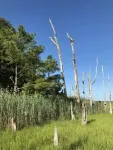(Press-News.org) Sunlight filters through the canopy of pines, holly, sweet gum, and red maple while bird calls echo in the distance. These coastal forests may seem like others in the Mid-Atlantic, but a hidden challenge looms. Standing tall next to their salt marsh neighbors, where the wind carries the sharp scent of sulfidic seawater, these trees are more than just part of the landscape—they are living monuments to a rapidly changing environment. As sea levels rise, the future of these forests is uncertain. While the adjacent salt marshes can adapt to encroaching waters, the trees, vulnerable to the increasing frequency of saltwater flooding, face a grimmer prospect. Additionally, temperatures are increasing, and rain patterns are shifting. How long can the forest withstand the pressure of a changing climate? When will they finally succumb to a rising tide?
Rising tides
Coastal forests occupy low-lying land just above sea level, situated beside tidal marshes. Being low and close to tidal channels, these forests can flood with saltwater, which may happen a few times a year or only during the most severe storms. However, as sea levels rise, the boundary between land and sea pushes upslope, leading to more frequent flooding. Tidal marshes dynamically build elevation or migrate upslope, maintaining their positions relative to flooding. Forests, however, are far less adaptable. Along the lower edges, individual trees begin to die, forcing the forest to retreat until what remains is a graveyard of dead trees—known as a ‘ghost forest.’ Here, salt-tolerant marsh plants, such as smooth cordgrass (Spartina alterniflora), take root and form a green carpet below the remains of the once-thriving forest. This shift is beneficial for tidal marshes, allowing them to expand even in the face of erosion or other threats, but it comes at the expense of the coastal forest.
The stark reality of this transition is already apparent in many coastal areas, where acres of dead trees stand as a testament to the encroaching saltwater. Retreating coastal forest can result in a loss of biodiversity, and perhaps carbon sequestration; if nothing else, it represents the loss of critical buffer space between the land and sea. Land slope plays a role in determining where these forests retreat, but the variability is enough to leave land managers questioning: Where will forests retreat and where will tidal marshes take their place? Proactive management is paramount, as once the trees begin to die, it is likely too late to alter their fate. To anticipate these changes, it is essential to understand the subtleties that occur before tree death. Signals of stress can be gleaned from how well trees are growing as flooding increases, temperature rises, and precipitation patterns change. These signals point towards what conditions may eventually lead to tree death, and depending on other characteristics of the forest, where coastal forests are more vulnerable to retreat.
Tree rings show highly specific effects of sea level rise
Our study delved into this using dendrochronology, the analysis of tree growth rings, to explore relationships between flooding, climate variables, and site-specific conditions. Dendrochronology allows us to understand the conditions under which trees thrive or struggle, with narrower growth rings indicating periods of stress. Traditionally, simple correlations have been used to study these relationships, but we employed a different technique: gradient boosted linear regression. This machine learning approach can uncover complexities that correlations might miss, such as non-linear growth patterns across a spectrum of environmental conditions. We applied this method at four sites, with three tree species common to coastal forests in New Jersey and Delaware: loblolly pine, pitch pine, and American holly.
Our hypothesis was that rising sea levels would lead to reduced growth across species. However, the results were far more nuanced. The effects of sea level rise on tree growth varied depending on temperature, precipitation, and the site. At one site, we found that American holly grew better when winter water levels were higher. Loblolly pines appeared vulnerable to autumn water levels. We also observed frequent non-linear growth responses, painting a more complicated picture of how these forests react to rising sea levels and climate change. We also analyzed whether the gradient-boosted results indicated that trees would fare better or worse under predicted changes in temperature, precipitation, and water levels. Our findings revealed few consistent patterns, highlighting the influence of species and site-specific factors on overall vulnerability.
Learning to manage coastal forests
Before trees reach the point of no return, the impacts of environmental changes on their growth are anything but simple. In some cases, climate change might even enhance resilience to increased flooding. For example, loblolly pine, situated at its northernmost distribution in our study sites, could benefit from warmer winters, perhaps offsetting some stress caused by flooding. Similarly, American holly showed markedly different results between two sites, possibly due to variations in moisture availability. These and other factors likely contribute to the variability in how and when specific coastal forests will retreat in response to sea level rise.
Overall, the effects of climate change and increased flood frequency on coastal forests are complex and often non-linear, highlighting the need for nuanced forest management strategies. In the future, similar dendrochronological studies could serve as valuable tools for assessing coastal forest vulnerability to climate change and sea level rise. Our findings aim to inform land management efforts, helping to strike a balance between conserving coastal forests and tidal marshes given the growing pressures of climate change and sea level rise.
END
Rising waters, waning forests: How scientists are using tree rings to study how rising sea levels affect coastal forests
Guest editorial by Dr LeeAnn Haaf, assistant director of Estuary Science, Partnership for the Delaware Estuary and author of a new Frontiers in Forests and Global Change article
2024-09-25
ELSE PRESS RELEASES FROM THIS DATE:
Night-time noise linked to restless nights for airport neighbours
2024-09-25
Noise from aircraft at night is linked with disturbed sleep quality and sleep-wake cycle, a new study using movement trackers has shown.
Environmental health experts at the University of Leicester combined measurements from activity monitors and self-reported sleep information for the first time to put together a more detailed picture of how aircraft noise impacts sleep, in the largest such study to date.
The results, published in Environmental Health Perspectives, show that people exposed to higher levels of night-time aircraft noise experienced more restlessness during sleep and disruption in daily sleep rhythm, even if they had a full night’s sleep.
The team was led from the ...
Fossils from the Adriatic Sea show a recent and worrying reversal of fortunes
2024-09-25
If you’d stopped monitoring the Adriatic Sea’s marine life in the mid-20th century, the outlook would have been promising. Snails and the clams they hunt for food increased in abundance for several decades during the late 1800s and early 1900s, evidence of a vibrant and healthy ecosystem.
Then, a threshold was crossed. Populations of both predator and prey abruptly plummeted and in some cases disappeared entirely. They were replaced by the common corbulid clam (Varicorbula gibba), which has the ability to slow down its metabolism in unfavorable conditions. Whenever paleontologists find an abundance of this species in the marine fossil record, it often means ...
With curtailed carbon emissions, corals can survive climate change
2024-09-25
KANEOHE, HI (Sept 24, 2024 1:05 p.m. HST)- In a study published today in Proceedings of the Royal Society B, researchers at the UH Hawaiʻi Institute of Marine Biology (HIMB) Toonen- Bowen “ToBo” Lab have identified scenarios under which eight of the most common species of coral found in Hawaiʻi can adapt to and survive ocean warming and acidification. The corals in the study are prevalent throughout the Indo-Pacific, a region that comprises more than two-thirds of the coral reefs on planet Earth, and were found to be capable of surviving a “low ...
Global prevalence of short-sightedness in children and teens set to top 740 million cases by 2050
2024-09-24
Around 1 in 3 children and teens around the world is short (near)-sighted, with the global prevalence of myopia set to top 740 million cases by 2050 in this age group, finds a pooled data analysis of the available evidence, published online in the British Journal of Ophthalmology.
Female sex, East Asian or urban area residence, and educational level all seem to be key factors influencing prevalence, the findings indicate.
Short (near)-sightedness (myopia), which describes difficulty seeing objects at a distance, typically starts in early childhood and tends to worsen with age, explain the researchers. It has emerged ...
Urgent rethink of bottled water’s huge and growing toll on human and planetary health
2024-09-24
The huge and growing toll bottled water is taking on human and planetary health warrants an urgent rethink of its use as 1 million bottles are bought every minute around the globe, with that figure set to rise further still amid escalating demand, warn population health experts in a commentary published in the open access journal BMJ Global Health.
Some 2 billion people around the world with limited or no access to safe drinking water rely on bottled water. But for the rest of us, it’s largely a matter of convenience and the unshaken belief—aided and abetted by industry marketing—that bottled water is safer and often healthier than tap ...
Women still missing out on treatment for their No 1 killer—cardiovascular disease
2024-09-24
Women in the UK, and elsewhere, are still missing out on vital treatment for their No 1 killer—cardiovascular disease—despite significant progress in the medical management of heart disease and stroke, concludes a consensus statement published online in the journal Heart.
They continue to be underdiagnosed, undertreated, and underrepresented in clinical trials in all areas of cardiovascular disease, says the statement. Among other things, it calls for dedicated women’s heart champions and heart hubs, plus a women’s ...
Palestinian education ‘under attack’, leaving a generation close to losing hope, study warns
2024-09-24
The ongoing war in Gaza will set children and young people’s education back by up to five years and risks creating a lost generation of permanently traumatised Palestinian youth, a new study warns.
The report, by a team of academics working in partnership with the United Nations Relief and Works Agency for Palestinian Refugees in the Near East (UNRWA), is the first to comprehensively quantify the war’s toll on learning since it began in October 2023. It also details the devastating impact on children, young people and teachers, supported by new accounts from frontline staff and ...
Semaglutide improves outcomes for obese patients with common skin condition, new study shows
2024-09-24
(Wednesday, 25 September 2024, Amsterdam, Netherlands) A pioneering study, presented today at the European Academy of Dermatology and Venereology (EADV) Congress 2024, demonstrates the significant potential of semaglutide in treating hidradenitis suppurative (HS), a common and chronic skin condition, in people with obesity.1
This is the first study to explore the use of semaglutide for HS, marking a critical milestone in the search for effective treatments for this painful and debilitating condition.
HS is currently estimated to affect approximately 1 in 100 people, with obesity being a significant risk factor. The condition is characterised ...
Could GLP1RA drugs lower high iron levels?
2024-09-24
GLP1RA agonists have been increasing in popularity for treating obesity and type 2 diabetes.
With this novel treatment proving to be very effective, researchers are curious to know more about what other potential treatments it could also hold.
Researchers at the University of Michigan investigated another potential way GLP1RA drugs can be useful in treating type two diabetes associated with a genetic condition that causes high levels of iron, called hereditary hemochromatosis.
High iron levels with hereditary hemochromatosis can cause predisposition to liver disease ...
C-Path’s PKD outcomes consortium receives BAA Award for project to advance drug development tools for autosomal dominant tubulointerstitial kidney disease
2024-09-24
TUCSON, Ariz., Sept. 19, 2024 — Critical Path Institute (C-Path) is thrilled to announce its Polycystic Kidney Disease Outcomes Consortium (PKDOC) has been awarded an Autosomal Dominant Tubulointerstitial Kidney Disease (ADTKD) focused Broad Agency Announcement (BAA) contract from the U.S. Food and Drug Administration (FDA). The overarching objective of the work supported by the BAA award is to leverage collaboration with the Wake Forest Rare Inherited Kidney Disease team and its ADTKD registry, to analyze clinical and laboratory data that will help evaluate prognosis in ADTKD and help set the stage for future clinical trials.
ADTKD only affects ...
LAST 30 PRESS RELEASES:
Researchers find promising new way to boost the immune response to cancer
Coffee as a staining agent substitute in electron microscopy
Revealing the diversity of olfactory receptors in hagfish and its implications for early vertebrate evolution
Development of an ultrasonic sensor capable of cuffless, non-invasive blood pressure measurement
Longer treatment with medications for opioid use disorder is associated with greater probability of survival
Strategy over morality can help conservation campaigns reduce ivory demand, research shows
Rising temperatures reshape microbial carbon cycling during animal carcass decomposition in water
Achieving ultra-low-power explosive jumps via locust bio-hybrid muscle actuators
Plant-derived phenolic acids revive the power of tetracycline against drug-resistant bacteria
Cooperation: A costly affair in bacterial social behaviour?
Viruses in wastewater: Silent drivers of pollution removal and antibiotic resistance
Sub-iethal water disinfection may accelerate the spread of antibiotic resistance
Three in four new Australian moms struggle with body image
Post-stroke injection protects the brain in preclinical study
Cardiovascular risk score predicts multiple eye diseases
Health: estimated one in ten British adults used or interested in GLP-1 medications for weight loss
Exercise to treat depression yields similar results to therapy
Whooping cough vaccination for pregnant women strengthens babies’ immune system
Dramatic decline in new cases of orphanhood in Uganda driven by HIV treatment and prevention programs
Stopping weight loss drugs linked to weight regain and reversal of heart health markers
Higher intake of food preservatives linked to increased cancer risk
Mass General Brigham–developed cholera vaccine completes phase 1 trial
First experimental validation of a “150-year-old chemical common sense” direct visualization of the molecular structural changes in the ultrafast anthracene [4+4] photocycloaddition reaction
Lack of support for people on weight loss drugs leaves them vulnerable to nutritional deficiencies, say experts
Dogs’ dinners can have greater climate impact than owners’
Are you ready to swap salmon for sprats and sardines?
1.6 million UK adults used weight loss drugs in past year
American College of Cardiology comments on new dietary guidelines for Americans
American Society of Gene & Cell Therapy and Orphan Therapeutics Accelerator partner to advance and commercialize promising rare disease treatments
One in 14 patients having day case surgery have new or worse chronic pain 3 months after their operation
[Press-News.org] Rising waters, waning forests: How scientists are using tree rings to study how rising sea levels affect coastal forestsGuest editorial by Dr LeeAnn Haaf, assistant director of Estuary Science, Partnership for the Delaware Estuary and author of a new Frontiers in Forests and Global Change article






